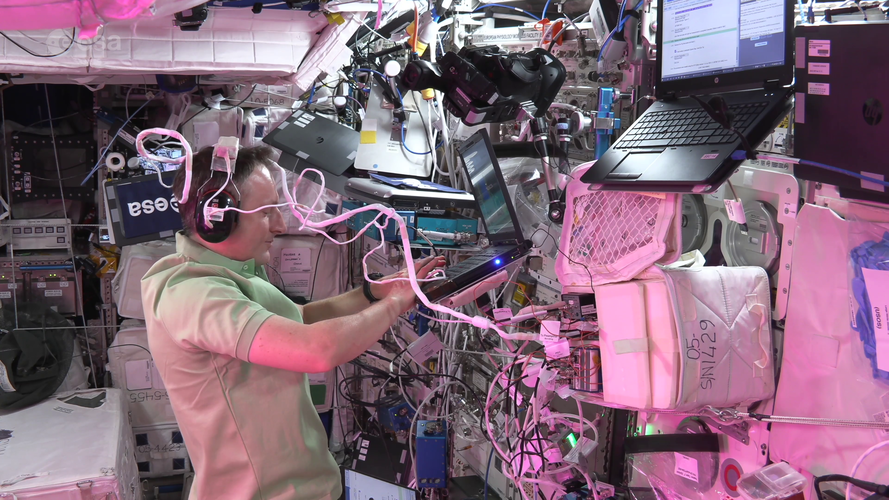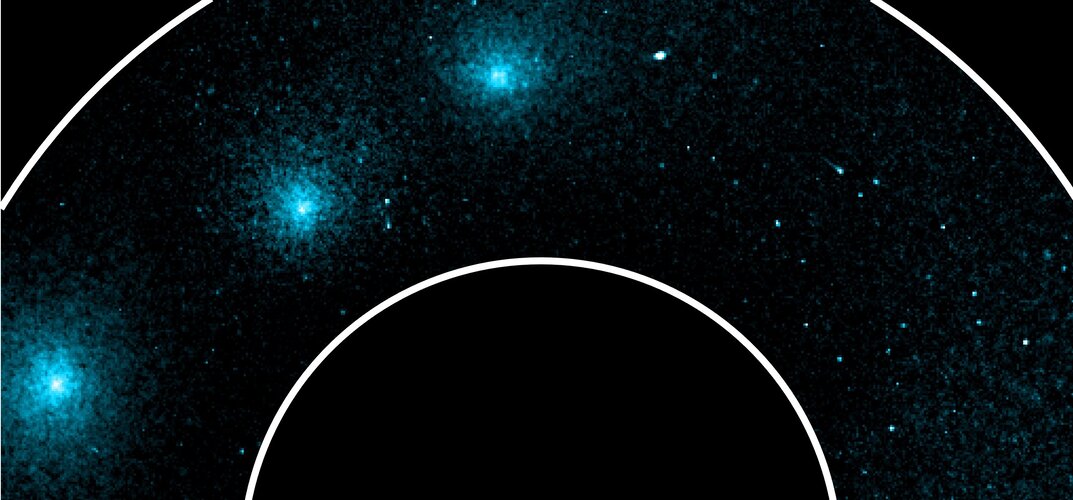
Copernical Team
Astronaut hearing test | Cosmic Kiss
 Video:
00:02:14
Video:
00:02:14
The International Space Station can be a noisy place. ESA astronaut Matthias Maurer is putting his hearing (and headphone untangling skills) to the test in an experiment called Acoustic Diagnostics.
Acoustic Diagnostics is an Italian Space Agency (ASI) experiment, developed in cooperation with the University of Rome Tor Vergata, to study the effects of microgravity on the hearing of astronauts. The study began during ESA astronaut Luca Parmitano’s mission and monitors what are known as optoacoustic emissions (OAEs).
OAEs are caused when hairs in the inner ear move in response to auditory stimulation. That means the measurement is passive.
Solar Orbiter catches a second comet by the tail

For the second time in its mission so far, the ESA/NASA Solar Orbiter spacecraft has flown through the tail of a comet. Predicted in advance by astronomers at University College London, UK, the spacecraft collected a wealth of science data that now awaits full analysis.
The beauty of the Sun seen from space
 Image:
The beauty of the Sun seen from space
Image:
The beauty of the Sun seen from space Sols 3362-3363: Sedimentologist's Delight
 After a few sols of challenges that prevented us from getting close-up MAHLI imaging of this dark outcrop in front of us, today we were finally able to plan the contact science that we were hoping for.
Yesterday there was a small rock under the right rear rover wheel, so we had to kick that rock to the curb to get into a stable position for using the rover arm. This morning's downlink data
After a few sols of challenges that prevented us from getting close-up MAHLI imaging of this dark outcrop in front of us, today we were finally able to plan the contact science that we were hoping for.
Yesterday there was a small rock under the right rear rover wheel, so we had to kick that rock to the curb to get into a stable position for using the rover arm. This morning's downlink data SpaceX ISS freighter splashes down off Florida
 A SpaceX Dragon capsule that had transported supplies and experiments to the International Space Station splashed down along the coast of Florida on Monday afternoon.
The capsule's four main parachutes were deployed shortly after 4 p.m. EST, and splashdown was confirmed two minutes later, the company said.
The freighter delivered some 4,900 pounds of science experiments and stati
A SpaceX Dragon capsule that had transported supplies and experiments to the International Space Station splashed down along the coast of Florida on Monday afternoon.
The capsule's four main parachutes were deployed shortly after 4 p.m. EST, and splashdown was confirmed two minutes later, the company said.
The freighter delivered some 4,900 pounds of science experiments and stati OneWeb and Hughes to bring orbital broadband service to India
 OneWeb, the low Earth orbit satellite communications company, and Hughes Network Systems LLC has announced a strategic six-year Distribution Partner agreement to provide low Earth orbit (LEO) connectivity services across India. The arrangement between OneWeb and Hughes Communications India Private Ltd. (HCIPL), a joint venture between Hughes and Bharti Airtel Limited, follows the Memorandum of U
OneWeb, the low Earth orbit satellite communications company, and Hughes Network Systems LLC has announced a strategic six-year Distribution Partner agreement to provide low Earth orbit (LEO) connectivity services across India. The arrangement between OneWeb and Hughes Communications India Private Ltd. (HCIPL), a joint venture between Hughes and Bharti Airtel Limited, follows the Memorandum of U Webb telescope reaches final destination, a million miles from Earth
 The James Webb Space Telescope has arrived at its cosmic parking spot a million miles away, bringing it a step closer to its mission to unravel the mysteries of the Universe, NASA said Monday.
At around 2:00 pm Eastern Time (1900 GMT), the observatory fired its thrusters for five minutes to reach the so-called second Lagrange point, or L2, where it will have access to nearly half the sky at
The James Webb Space Telescope has arrived at its cosmic parking spot a million miles away, bringing it a step closer to its mission to unravel the mysteries of the Universe, NASA said Monday.
At around 2:00 pm Eastern Time (1900 GMT), the observatory fired its thrusters for five minutes to reach the so-called second Lagrange point, or L2, where it will have access to nearly half the sky at Orbital Insertion Burn a Success, Webb Arrives at L2
 At 2 pm EST Monday, Webb fired its onboard thrusters for nearly five minutes (297 seconds) to complete the final postlaunch course correction to Webb's trajectory. This mid-course correction burn inserted Webb toward its final orbit around the second Sun-Earth Lagrange point, or L2, nearly 1 million miles away from the Earth.
The final mid-course burn added only about 3.6 miles per hour (1
At 2 pm EST Monday, Webb fired its onboard thrusters for nearly five minutes (297 seconds) to complete the final postlaunch course correction to Webb's trajectory. This mid-course correction burn inserted Webb toward its final orbit around the second Sun-Earth Lagrange point, or L2, nearly 1 million miles away from the Earth.
The final mid-course burn added only about 3.6 miles per hour (1 Looking Up at the Asteroids in the Neighborhood
 Asteroids fly through our solar system all the time, but it's rare for us to take notice of them. But that's changed this week, as an asteroid passes within 1,231,184 miles of Earth on January 18. The asteroid, dubbed 7482 (1994 PC1), was first seen in 1994 and is about two-thirds of a mile wide.
One likely reason Americans are paying more attention is because many millions have watched th
Asteroids fly through our solar system all the time, but it's rare for us to take notice of them. But that's changed this week, as an asteroid passes within 1,231,184 miles of Earth on January 18. The asteroid, dubbed 7482 (1994 PC1), was first seen in 1994 and is about two-thirds of a mile wide.
One likely reason Americans are paying more attention is because many millions have watched th How to Retain a Core
 Pasadena CA (JPL) Jan 25, 2022
Have you ever wondered how a coring bit grabs and holds onto a rock core?
As we drill, the bit teeth cut a 27mm diameter circle in the rock and leave the 13mm diameter center intact. As we dig deeper, that cylinder of rock is fed into the sample tube that was loaded inside the bit. When the drill reaches its target depth, typically 66mm, the core is fully in
Pasadena CA (JPL) Jan 25, 2022
Have you ever wondered how a coring bit grabs and holds onto a rock core?
As we drill, the bit teeth cut a 27mm diameter circle in the rock and leave the 13mm diameter center intact. As we dig deeper, that cylinder of rock is fed into the sample tube that was loaded inside the bit. When the drill reaches its target depth, typically 66mm, the core is fully in 
